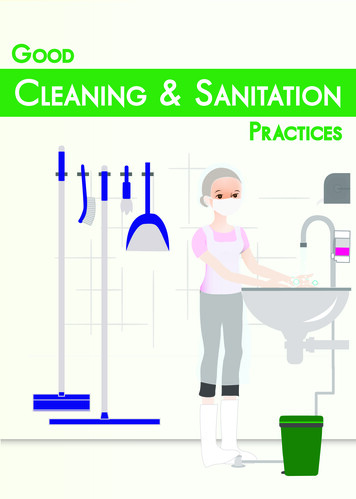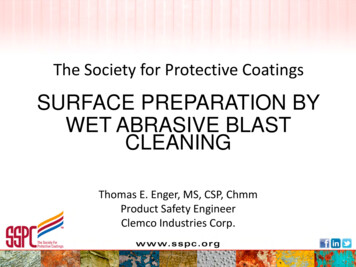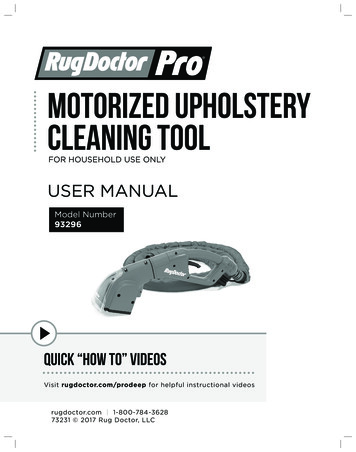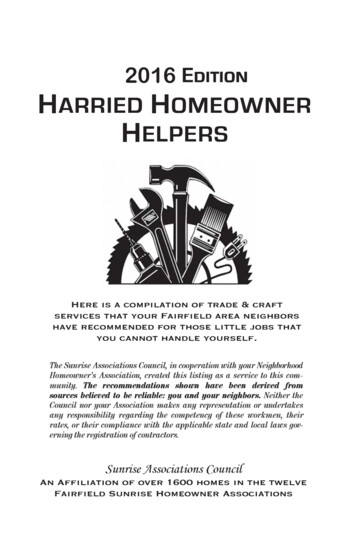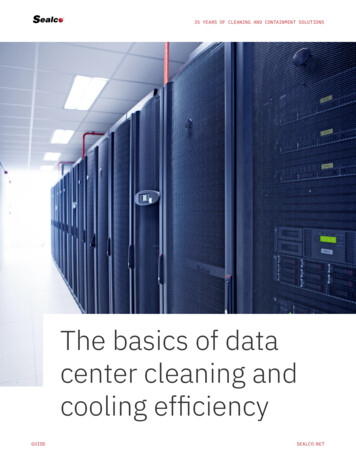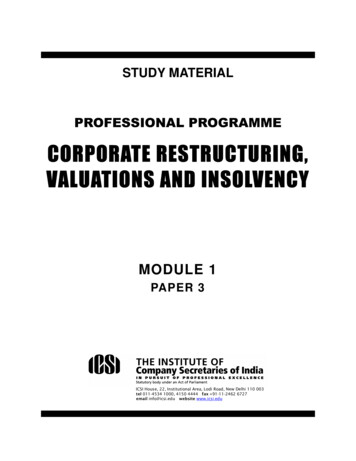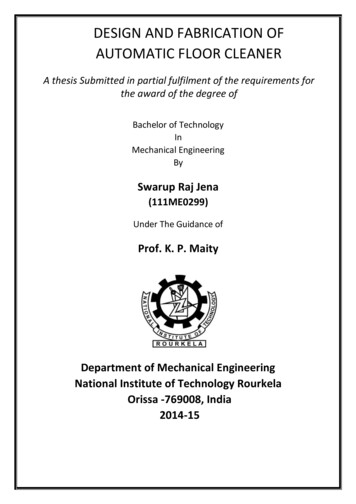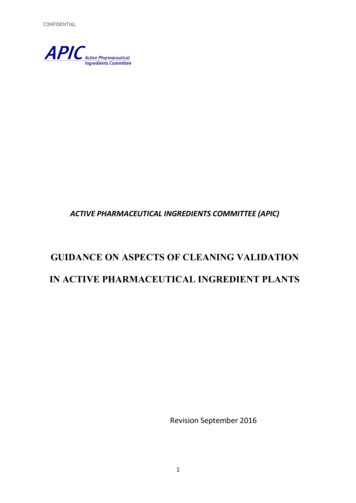
Transcription
CONFIDENTIALACTIVE PHARMACEUTICAL INGREDIENTS COMMITTEE (APIC)GUIDANCE ON ASPECTS OF CLEANING VALIDATIONIN ACTIVE PHARMACEUTICAL INGREDIENT PLANTSRevision September 20161
CONFIDENTIALTable of CE CRITERIA4.1Introduction4.2Methods of Calculating Acceptance Criteria4.2.1. Acceptance criteria using health-based data4.2.2Acceptance criteria based on Therapeutic Daily Dose4.2.3. Acceptance criteria based on LD504.2.4General Limit as acceptance criteria4.2.5Swab Limits4.2.6 Rinse Limits4.2.7 Rationale for the use of different limits in pharmaceutical and chemicalproduction5.0LEVELS OF CLEANING5.1Introduction5.2Cleaning Levels5.3Cleaning Verification/Validation6.0CONTROL OF CLEANING PROCESS7.0BRACKETING AND WORST CASE RATING7.1Introduction7.2Bracketing Procedure7.3Cleaning Procedures7.4Worst Case Rating8.0DETERMINATION OF THE AMOUNT OF RESIDUE8.1Introduction8.2Validation Requirements8.3Sampling Methods8.4Analytical Methods9.0CLEANING VALIDATION bility2
CONFIDENTIAL9.5Sampling Procedure9.6Testing procedure9.7Acceptance criteria9.8Deviations9.9Revalidation10.0VALIDATION QUESTIONS11.0REFERENCES12.0GLOSSARY13.0COPYRIGHT AND DISCLAIMER3
CONFIDENTIAL1.0FOREWORDThis guidance document was updated in 2014 by the APIC Cleaning Validation Task Forceon behalf of the Active Pharmaceutical Ingredient Committee (APIC) of CEFIC.The Task Force members were:- Annick Bonneure, APIC, Belgium- Tom Buggy, DSM Sinochem Pharmaceuticals, the Netherlands- Paul Clingan, MacFarlan Smith, UK- Anke Grootaert, Janssen Pharmaceutica, Belgium- Peter Mungenast, Merck KGaA, Germany.- Luisa Paulo, Hovione FarmaCiencia SA, Portugal- Filip Quintiens, Genzyme, Belgium- Claude Vandenbossche, Ajinomoto Omnichem, Belgium- Jos van der Ven, Aspen Oss B.V., the Netherlands- Stefan Wienken, BASF, GermanyWith support and review from:- Pieter van der Hoeven, APIC, Belgium- Anthony Storey, Pfizer, UK- Rainer Fendt, BASF, GermanyA further revision of the guidance document has now been done in 2016 to bring it in linewith the European Medicines Agency Guidance on use of Health Based data to setacceptance criteria for cleaning. The main changes were introduced in Chapter 4, AcceptanceCriteria.The subject of cleaning validation in active pharmaceutical ingredient manufacturing plantshas continued to receive a large amount of attention from regulators, companies andcustomers alike.The integration of Cleaning Validation within an effective Quality System supported byQuality Risk Management Processes should give assurance that API ManufacturingOperations are performed in such a way that Risks to patients related to cleaning validationare understood, assessed for impact and are mitigated as necessary.It is important that the requirements for the finished manufacturing companies are nottransferred back in the process to active pharmaceutical ingredient manufacturers withoutconsideration for the different processes that take place at this stage.For example, higher limits may be acceptable in chemical production compared topharmaceutical production because the carry-over risk is much lower for technical andchemical manufacturing reasonsThe document reflects the outcome of discussions between APIC member companies on howcleaning validation requirements could be fulfilled and implemented as part of routineoperations.4
CONFIDENTIALIn addition, APIC has aligned this guidance with the ISPE Risk MaPP Guide1 that follows theQuality Risk Management Processes as described in the ICH Q9 Guidance on Quality RiskManagement.A further revision of the Guidance has now been done to include the general principles of theEMA Guideline2 on setting health based exposure limits for determining safe thresholdvalues for the cleaning of API’s in shared facilities.The criteria of Acceptable Daily Exposure (ADE) or Permitted Daily Exposure (PDE) arerecommended to be used by companies to decide if Dedicated Facilities are required or notand to define the Maximum Acceptable Carry Over (MACO) of API’s in particular, in MultiPurpose Equipment.Chapter 6 defines factors that should be considered in controls of the cleaning processes tomanage the risks related to potential chemical or microbiological contamination.The PDA Technical Report No. 29 – Points to Consider for Cleaning Validation3 is alsorecommended as a valuable guidance document from industry.The following topics are discussed in the PDA document: Cleaning process (CIP/COP):design and qualification-2.0Types of residues, setting acceptance criteria, sampling and analytical methodsMaintenance of the validated state: critical parameters measurements, process alarms,change control, trending & monitoring, training and periodic reviewDocumentationObjectiveThis document has been prepared to assist companies in the formulation of cleaningvalidation programmes and should not be considered as a technical standard but a starting1ISPE Baseline Pharmaceutical Engineering Guide, Volume 7 – Risk-Based Manufacture of PharmaceuticalProducts, International Society for Pharmaceutical Engineering (ISPE), First Edition, September 2010,www.ispe.org.2European Medicines Agency, EMA/CHMP/CVMP/SWP/169430/2012, Guideline on setting health basedexposure limits for use in risk identification in the manufacture of different medicinal products inshared facilities.3Parenteral Drug Association (PDA) Guidance for Industry. Technical Report No. 29 (Revised 2012) Points toConsider for Cleaning Validation, Destin A. LeBlanc, Gretchen Allison, Jennifer L. Carlson, KoshyGeorge, Igor Gorsky, Irwin S. Hirsh, Jamie Osborne, Greg Randall, Pierre-Michel Riss, GeorgeVerghese, Jenn Walsh, Vivienne Yankah.5
CONFIDENTIALpoint for internal discussions. The document includes examples on how member companieshave dealt with specific areas and issues that arise when performing cleaning validation.3.0ScopeSix specific areas are addressed in this Guidance document: Acceptance CriteriaLevels of CleaningControl of the cleaning processBracketing and Worst Case RatingDetermination of the amount of residueCleaning Validation ProtocolFinally, the most frequently asked questions are answered to give further guidance on specificpoints related to cleaning validation.4.0Acceptance Criteria4.1. IntroductionCompanies must demonstrate during validation that the cleaning procedure routinelyemployed for a piece of equipment limits potential carryover to an acceptable level. Thelimits established must be calculated based on sound scientific rational.This section provides practical guidance as to how those acceptance criteria can becalculated. It is important that companies evaluate all cases individually. There may bespecific instances where the product mix in the equipment requires further consideration.The acceptance criteria preferably should be based on the Acceptable Daily Exposure (ADE)or Permitted Daily Exposure (PDE) calculations whenever this data is available.The APIC Guidance refers primarily to ADE in the examples of calculations included in thischapter, in line with the ISPE recommended calculations.The ADE/ PDE define limits at which a patient may be exposed every day for a lifetime withacceptable risks related to adverse health effects. Calculations of ADE/ PDE of API’s andintermediates are usually done with involvement of industrial hygienists and toxicologists,who review all available toxicology and clinical data to set the limits. The justification of thecalculation should be documented.In many cases Occupational Exposure Limits (OEL) will be defined for API’s, Intermediatesand Industrial Chemicals by Industrial Hygienists and toxicologists and the OEL data is thenused to define containment measures such that operators are adequately protected whileworking with the chemicals.The OEL data can also be used to calculate the ADE / PDE for setting the acceptance criteriafor cleaning of equipment.6
CONFIDENTIALIn certain cases where availability of pharmacological or toxicological data is limited, forexample for chemicals, raw materials, Starting Materials, intermediates or API’s in earlyphase clinical trials, cleaning limits based on fraction of clinical doses, LD50 and / or generalcleaning limits may be calculated. In these cases, carcinogenic, genotoxic and potency effectof these structures should be evaluated by toxicologists.The acceptance criteria for equipment cleaning should be based on visually clean in dryconditions and an analytical limit.Unlike in pharmaceutical production, where residues on the surface of equipment may be 100% carried over to the next product, in API production the carry-over risk is much lower fortechnical and chemical manufacturing reasons. Therefore all the following examples forcalculating the limits can be adapted to the suitable situation by using different factors. Acompetent chemist with detailed knowledge about the equipment and the chemical processesand the properties of the chemicals involved such as solubility should justify this factor byevaluating the specific situation.7
CONFIDENTIAL4.2.Methods of Calculating Acceptance Criteria4.2.1 Acceptance criteria using health-based dataThe Maximum Allowable Carryover (MACO) should be based upon the Acceptable DailyExposure (ADE) or Permitted Daily Exposure (PDE) when this data is available. Theprinciple of MACO calculation is that you calculate your acceptable carry-over of yourprevious product, based upon the ADE / PDE, into your next product.ProcedureCalculate the ADE (Acceptable Daily Exposure) or PDE (Permitted Daily Exposure)according to the following equations and use either result for the calculation of the MACO.NOAEL x BWADE -----------------------------UFc x MF x PKNOAEL x BWPDE -----------------------------F1 x F2 x F3 x F4 x F5From the ADE / PDE number, a MACO can be calculated according to:MACO ADE / PDE previous x -TDDnextMACOMaximum Allowable Carryover: acceptableprevious product into your next product (mg)ADEPDENOAELBWUFcAcceptable Daily Exposure (mg/day)Permitted Daily Exposure (mg/day)No Observed Adverse Effect Level (mg/kg/day)Is the weight of an average adult (e.g. 70 kg)Composite Uncertainty Factor: combination of factors which reflects the interindividual variability, interspecies differences, sub-chronic-to-chronicextrapolation, LOEL-to-NOEL extrapolation, database completeness.Modifying Factor: a factor to address uncertainties not covered by the otherfactorsPharmacokinetic AdjustmentsAdjustment factors to account for uncertainties. Refer to EMA Guidance 2 for n.TDDnextMBSnextStandard Therapeutic Daily Dose for the next product (mg/day)Minimum batch size for the next product(s) (where MACO can end up) (mg)8
CONFIDENTIALInstead of calculating each potential product change situation, the worst case scenario can bechosen. Then a case with most active API (lowest ADE or PDE) is chosen to end up in thefollowing API with the smallest ratio of batch size divided with TDD (MBS/TDD ratio).If OEL data is available, the ADE or PDE can be derived from the OEL.4.2.2. Acceptance criteria based on Therapeutic Daily DoseWhen limited toxicity data is available and the Therapeutic Daily Dose (TDD) is known, thiscalculation may be used. It is used for final product changeover API Process —A to APIProcess —B.ProcedureEstablish the limit for Maximum Allowable Carryover (MACO) according tothe following equation.MACO MACOTDDpreviousTDDnextMBSnextSFTDDprevious x MBSnext-------------------------------------SF x TDDnextMaximum Allowance Carryover: acceptable transferred amountfrom the previous product into your next product (mg)Standard Therapeutic Daily Dose of the investigated product (inthe same dosage from as TDDnext) (mg/day)Standard Therapeutic Daily Dose for the next product (mg/day)Minimum batch size for the next product(s) (where MACO canend up (mg)Safety factor (normally 1000 is used in calculations based onTDD).9
CONFIDENTIAL4.2.3.Acceptance criteria based on LD50In cases where no other data is available (e.g. ADE, OEL, TDD, ) and only LD50 data isavailable (e.g. chemicals, intermediates, detergents, ), the MACO can be based upon LD50data.ProcedureCalculate the so called NOEL number (No Observable Effect Level) according to thefollowing equation and use the result for the establishment of MACO (See [3] on page 53 for reference).LD50 x BWNOEL --------------------------2000From the NOEL number a MACO can be calculated according to:MACO previous x next x TDDnextMaximum Allowance Carryover: acceptable transferred amount fromthe previous product into your next product (mg)No Observed Effect Level (mg/day)Lethal Dose 50 in mg/kg animal. The identification of the animal(mouse, rat etc.) and the way of entry (IV, oral etc.) is important(mg/kg)Is the weight of an average adult (e.g. 70 kg) (kg)2000 is an empirical constantStandard Therapeutic Daily Dose for the next product (mg/day)Minimum batch size for the next product (s) (where MACO can endup)Safety factorThe safety factor (SF) varies depending on the route of administration (see below). Generallya factor of 200 is employed when manufacturing APIs to be administered in oral dosageforms.Safety factors:TopicalsOral productsParenterals10 – 100100 – 10001000 – 10 00010
CONFIDENTIAL4.2.4 General Limit as acceptance criteriaIf MACO calculations result in unacceptably high or irrelevant carryover figures, ortoxicological data for intermediates are not known, the approach of a general limit may besuitable. Companies may choose to have such an upper limit as a policy. The general limit isoften set as an upper limit for the maximum concentration (MAXCONC) of a contaminatingsubstance in a subsequent batch.ProcedureEstablish MACOppm, based on a general limit, using the following equations.MACOppm MAXCONC x MBSMACOppmMAXCONCMBSMaximum Allowable Carryover: acceptable transferred amount fromthe investigated product (“previous”). Calculated from general ppmlimit.General limit for maximum allowed concentration (kg/kg or ppm) of“previous” substance in the next batch.Minimum batch size for the next product(s) (where MACO can endup)E.g. for a general limit of 100 ppm: MACO 0.01% of the minimum batch size (MBS), andfor a general limit of 10 ppm: MACO 0.001% of the minimum batch size (MBS).A general upper limit for the maximum concentration of a contaminating substance in asubsequent batch (MAXCONC) is often set to 5-500 ppm (100 ppm in APIs is very frequent)of the previous product into the next product depending on the nature of products producedfrom the individual company (e.g. toxicity, pharmacological activity, ).The Threshold of Toxicological Concern (TTC) concept could be applied to intermediates orAPI’s with no clinical (e.g. early development) or toxicological data. This concept includesthree categories of products with limited or no data: Products that are likely to be carcinogenic; Products that are likely to be potent or highly toxic; Products that are not likely to be carcinogenic, potent or highly toxic.The corresponding ADE’s recommended for these three categories are 1, 10, 100 µg/day,respectively.Note - If you decide to employ the concept of levels of cleaning (ref. section 5), then differentsafety factors (ppm limits) may be used for different levels. Especially if the product cleanedout is within the same synthetic chain and covered by the specification of the API, muchhigher (qualified) levels are acceptable.4.2.5 Swab LimitsIf homogeneous distribution is assumed on all surfaces, a recommended value can be set forthe content in a swab. The maximum allowable carry over from one batch to another can beestablished based on e.g. ADE, NOEL or TDD (see above). If the total direct contact surfaceis known, the target value for contamination per square meter can be calculated according11
CONFIDENTIALequation 4.2.5-I. This can be used as basic information for preparation of a method ofanalysis and detection limit.2MACO [µg]Equation 4.2.5-I Target value [µg/dm ] ------------------------2Total surface [dm ]Also other methods with different swab limits for different surfaces in a piece of equipmentand/or equipment train can be used. If the equipment can be divided in several parts, differentswab limits may be taken for the different parts building up the equipment train. If the resultof one part is exceeding the target value, the whole equipment train may still be within theMACO limit. The Carry Over is then calculated according equation 4.2.5-II (see below).During equipment qualification and cleaning validation hard to clean parts can bedetermined. Rather than declaring the hard to clean part as the worst case swab limit for thewhole equipment train, it could be separated and dealt with as mentioned above. It should benoted that different types of surfaces (e.g. stainless steel, glass lined, Teflon) may showdifferent recoveries during swabbing. In those cases it may be beneficial to divide theequipment train in several parts, and combine the results in a table or matrix. The totalcalculated amount should be below the MACO, and the individual swab results should notexceed the maximum expected residues established during cleaning validation / equipmentqualification. Recovery studies and method validation are necessary when applying swabbingas a method to determine residues.12
CONFIDENTIALEquation 4.2.5-IICO µg CO22Σ ( Ai [dm ] x mi [µg/dm ] )AiTrue (measured) total quantity of substance (possible carryover) on thecleaned surface in contact with the product, calculated from results of swabtests.Area for the tested piece of equipment # i.mi22Quantity in µg/dm , for each swab per area of swabbed surface (normally 1 dm )4.2.5.1.Setting Acceptance Criteria for Swab LimitsFor each item tested, the following acceptance criteria (AC) apply.AC1. The cleaning result of an individual part should not exceed the maximum expectedresidue.AC2. For the total equipment train the MACO must not be exceeded.In determining acceptance limits, all possible cases of following products in the relevantequipment shall be taken into account. It is proposed that a matrix be set up in which thelimits for all cases are calculated. Either acceptance criteria for each product in the equipmentcan be prepared or the worst case of all product combinations may be selected.4.2.5.2.Evaluation of resultsWhen all surfaces have been sampled and the samples have been analyzed, the results arecompared to the acceptance criteria. Companies may find it easier to evaluate against theMACO. However, it is advisable to have a policy for swab limit as well. Especially becauseanalytical methods are validated within a certain range for swab results. Another reason isthat some pieces could be very contaminated, and it is not good practice to clean certainpieces very thoroughly in order to let others be dirty. Thus, limits for both MACO and swabsshould be set.4.2.6.Rinse LimitThe residue amount in equipment after cleaning can also be determined by taking rinsesamples. During equipment qualification it should be established that all direct content partsof the equipment is wetted / reached by the rinsing solvent. After the last cleaning cycle (lastrinse), the equipment should be assessed as ‘clean’. In some cases it may be advisable to drythe equipment in order to do a proper assessment. Thereafter, the rinse cycle can be executed,and a sample taken (sampling rinse). The procedure for the rinse cycle and sampling shouldbe well established and described to assure repeatability and comparability (cycle times,temperatures, volumes, etc.). The choice of the rinse solvent should be established duringcleaning validation, taking into account solubility of the contaminations, and reactivity of therinse solvent towards the contaminants (saponification, hydrolyses, etc). Method validation isneeded.13
CONFIDENTIALIn a worst case approach, the amount of the residue in the equipment can be assumed to beequal to the amount determined by analysis of the rinse sample. This can be supported byrinse studies that show a strong decay of a residue in a piece of equipment.The MACO is usually calculated on each individual product change over scenario accordingto the procedures outlined above and individual acceptance criteria are established using thefollowing equation:Target value (mg/L) MACO (mg) / Volume of rinse or boil (L)For quantitation a solvent sample (e.g. 1 L) is taken, the residue in the sample is determinedby a suitable analytical method and the residue in the whole equipment is calculatedaccording to the following equation:M V*(C-Cb)MVCCbAmount of residue in the cleaned equipment in mgVolume of the last rinse or wash solvent portion in LConcentration of impurities in the sample in mg/LBlank of the cleaning or rinsing solvent in mg/L. If several samples aretaken during one run, one and the same blank can be used for allsamples provided the same solvent lot was used for the whole run.Requirement: M Target value.The requirement is that M target value. If needed, the sample can be concentrated beforeanalysis.The choice for swab or rinse sampling usually depends on the type of equipment. Areas to beswabbed are determined during equipment and cleaning validation (‘hard to clean areas’),and are preferably readily accessible for operational reasons, e.g. near the manhole. Ifswabbing of the indicated area is not easy, rinse sampling is the alternative. The advantage isthat the whole surface of the equipment is sampled for contamination, being provided thatduring equipment qualification, surface wetting testing was taken into account. Thusequipment used for milling, mixing, filters, etc. are usually swabbed, whilst reactor systemsare usually sampled by rinsing.14
CONFIDENTIAL4.2.7 Rationale for the use of different limits in pharmaceutical andchemical productionUnlike in pharmaceutical production, where residues on the surface of equipment may be100 % carried over to the next product, in API production the carry-over risk is much lowerfor technical and chemical manufacturing reasons. Thus higher limits may be acceptable inchemical production compared to pharmaceutical production. For example chemicalprocessing steps often include dissolution, extraction and filtration steps that are likely toreduce significantly any residue left from previous production and cleaning operations. Afactor of 5-10 could be applied to the MACO calculated using the Acceptable Daily ExposureLimit or the secondary criteria defined in the previous sections.In all cases, the limits should be justified by a competent chemist with detailed knowledgeabout the equipment and the chemical processes, following Quality Risk ManagementPrinciples and the limits should be approved by Operations and Quality Assurance Managers.The following description shows an example where the carry-over risk for a residue inchemical production equipment is much lower than in pharmaceutical production equipment.Assuming that the common criteria (ADE, PDE, 1/1000th dose, LD50 NOEL/ADI with SF100-1000, 10 ppm) represent the state of the art for pharmaceutical production and areconsidered sufficiently safe, then the calculation of limits in API manufacture must reflect thedifferent processes in pharmaceutical production and in the chemical production of activepharmaceutical ingredients to allow comparable risk analyses to be undertaken.Pharmaceutical production, Chemical production physical processIn pharmaceutical production a residue remaining on the surface of equipment after cleaningis, in the next production cycle, distributed in a mixture of active substance and excipients ifit does not remain on the surface. In the worst case it will be 100 % transferred to the firstbatch of next product.Residue on thesurface of ablets
CONFIDENTIALChemical production/processingIn chemical production a 100 % carry-over of residue from the equipment surface to the nextproduct to be manufactured is very unlikely based on the way the process is run and ontechnical considerations. The residue remaining on the equipment surface can, during thenext production cycle, be carried over into the reaction mixture consisting of solvent and rawmaterials. In most cases, however, any residue in solution will be eliminated from the processtogether with the solvent, and insoluble residue by physical separation processes (e.g.filtration), so likely carry over into the end-product will be low.The final step in a multi-step chemical synthesis is selective purification of the API (e.g. bycrystallization), during which contaminants are removed from the process and/or insolubleresidues are removed by physical separation). From the original reaction mixture of educt,agent and solvent there remains only a fraction of the original mass as API at the end of thechemical process.It is also to be noted that, during subsequent pharmaceutical production, the API is furtherdiluted through the excipients that are added.Residue solvedResidue onthe surface ofcleanedequipmentResidue solvedin waste solventResiduewithsolventNew API crystallisedin the reaction mixtureNew APIConclusion:Assuming that there is no intention to impose more stringent yardsticks during APIproduction than in pharmaceutical production but that they should be approximately thesame, the logical conclusion is that the limits in chemical production should be set higherthan in pharmaceutical production. Based on this rationale, a factor of 5 - 10 compared to theestablished pharmaceutical production limits is both plausible and, in terms of pharmaceuticalrisk, acceptable.Chemical production “physical processes” (drying, mixing, filling, .)16
CONFIDENTIALApparatus and equipment that is used for physical end-treatments such as drying, mixing ormilling may either be operated together with the previous synthesis equipment or generallybe used separately. During separate physical end-treatments of APIs, there is no decrease ofcontaminants compared to the aforementioned chemical process. Consequently, werecommend in this case that the calculation methods applied should be those normally used inpharmaceutical production, (ADE, PDE 1/1000th dose, LD50 NOEL/ADE with SF 100-1000,10 ppm). The Limits for carry over into the final API should be the same as those calculatedin the previous sections.ANNEX 1: Examples of MACO calculations.Example 1: ADE calculationProduct A has a NOAEL70kg of 100 mg/day human oral dose. Uncertainty factors applied tocalculate the ADE are an UFS of 3 (extrapolation from an acute dose to subchronic/chronicdosing) and UFH of 8.13 (the inter-individual variability based upon a PK (kineticcomponent) of 2.54 and PD of 3.2 (dynamic component)). The MF is 10 (extrapolation froma ‘generally healthy’ population to a more susceptible sick patient population). Product B isan oral product (PK 1).ADE 100 (mg/day)-----------------------------------3 x 8.13 x 10 x 1 410 (µg/day)Result: ADEoral is 410 µg/dayIf product B is a parenteral product and the PK is 62.5 (based upon an oral bio-availabilitystudy in human after parenteral).ADE 100 (mg/day)-----------------------------------3 x 8.13 x 10 x 62.5 6.6 (µg/day)Result: ADEparenteral is 6.6 µg/dayExample 2: ADE calculationA teratogenic product A has a LOAEL of 1 mg/kg.day human oral dose (BW is 70 kg).Uncertainty factors applied to calculate the ADE are an UFL of 3 (extrapolation from LOAELto NOAEL), an UFH of 10 (the inter-individual variability) and a MF of 10 (severity of effect:teratogenicity). Product B is an oral product (PK 1).ADE 1 (mg/kg.day) x 70 kg-----------------------------------3 x 10 x 10 x 117 231 (µg/day)
CONFIDENTIALResult: ADEoral is 231 µg/dayExample 3: Acceptance criteria based on Acceptable Daily ExposureProduct A will be cleaned out. The product has an ADE of 2 µg and the batch size is 200 kg.The next product B has a standard daily dose of 250 mg and the batch size is 50 kg. Calculatethe MACO for A in B.MACO 0.002 (mg) x 50 000 000 (mg)-----------------------------------250 (mg) 400 (mg)Result: MACO is 0.4 g (400 mg)Example 4: Acceptance criteria based on Therapeutic Daily DoseProduct A will be cleaned out. The product has a standard daily dose of 10 mg and the batchsize is 200 kg. The next product B has a standard daily dose of 250 mg and the batch size is50 kg. Both A and B are administrated orally and SF is set to 1000. Calculate the MACO forA in B.MACO 10 (mg) x 50 000 000 (mg)-----------------------------------1000 x 250 (mg)Result: MACO is 2 g (2000 mg)18 2 000 (mg)
CONFIDENTIALExample 5: Acceptance criteria based on Therapeutic Daily DoseNow product B in example 1 will be cleaned out. The following product is product A inexample 1. Calculate the MACO for B in A.MACO 250 (mg) x 200 000 000 (mg)---------------------------------------1000 x 10 (mg) 5 000 000 (mg)Result: MACO is 5 kg (5 000 000 mg)5.0Levels of Cleaning5.1IntroductionThe manufacturing process of an Active Pharmaceutical Ingredient (API) typicallyconsists of various chemical reaction and purification steps followed by physicalchanges. In general, early steps undergo further processing and purification and sopotential carryover of the previous product would be removed.The level of cleaning required in order to ensure that the API is free fromunacceptable levels of contamination by previous substances varies depending on thestep being cleaned and the next substance being manufactured in the same piece ofequipment (train).API s and related intermediates are often produced in multi-purpose equipment withfrequent product changes which results in a high amount of cleaning. To minimize the
A further revision of the guidance document has now been done in 2016 to bring it in line . Chapter 6 defines factors that should be considered in controls of the cleaning processes to . UFc Composite Uncertainty

